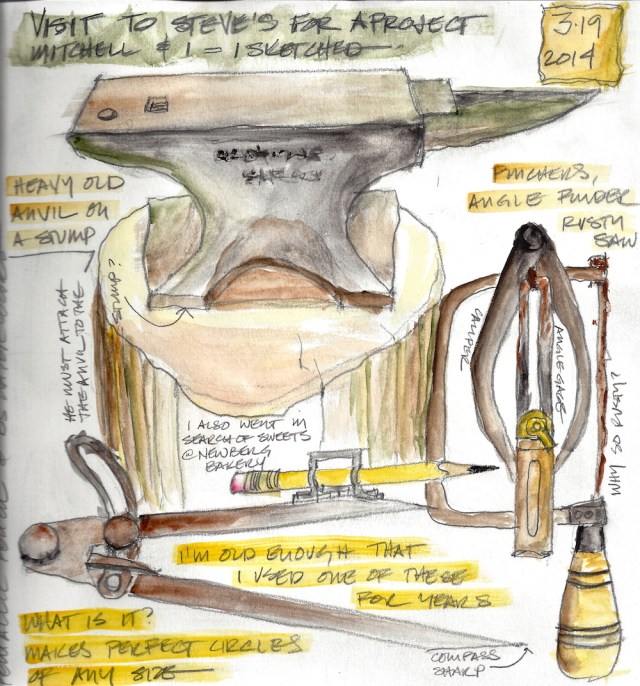In our business we work with many specialty trades, and one of my favorites is blacksmithing. It is a macho cool thing to take steel and heat it and fashion it into usable parts, and a special talent to be able to reproduce old parts so that they look authentic and function appropriately. Good blacksmiths see their predecessors works like handwriting forgers see a signature: they can tell you if the previous blacksmith was right or left-handed, and how they used their tools.
Below, nails pulled from an Eastlake sofa-bed. Had this been a museum project, nails might have been reproduced, and these placed on display. Nails can become fatigued, so that even if you straighten them, they cannot be used again. (A bit later I will post “N is for Nails.)
 We have worked with a few blacksmiths over the years, and we look for those that honor the old tradition. We met Stephen during the Oregon Caves National Park project, when we had to strengthen a Mason Monterey chair to withstand kids and even adults from sliding into the comfy seat over the top of the arms, as is demonstrated by the NPS curator, below. These struts were not originally part of this style chair, and this may be why there are so few of them around, as this was one of the earliest models of Mason produced. We studied some of their later chairs, and Stephen helped us to design struts that look as if Mason would have had them on the chair, down to matching hammer marks created by Mason’s blacksmith. We painted them, as Mason did so often, and now the chair has a structural strength previously lacking.
We have worked with a few blacksmiths over the years, and we look for those that honor the old tradition. We met Stephen during the Oregon Caves National Park project, when we had to strengthen a Mason Monterey chair to withstand kids and even adults from sliding into the comfy seat over the top of the arms, as is demonstrated by the NPS curator, below. These struts were not originally part of this style chair, and this may be why there are so few of them around, as this was one of the earliest models of Mason produced. We studied some of their later chairs, and Stephen helped us to design struts that look as if Mason would have had them on the chair, down to matching hammer marks created by Mason’s blacksmith. We painted them, as Mason did so often, and now the chair has a structural strength previously lacking.
As aside, and a glimpse into the thinking process of how conservators, whose intent is to preserve history and value for antiquities, must look at changes such as the structural struts. We researched other cases whereby conservators had had to perform restoration, versus conservation, by adding an entirely new piece in order to save the historical item. We found an excellent precedent in the U.S. Senate Desks, and were able to show our curator that this type of restoration was done for preservation considerations. In the Senate desks, which are both historical and used daily by senators, the feet were disintegrating. They had a blacksmith fashion replicas of the carved wooden feet to slip over the wearing original stumps, to preserve the overall desks for another century. (I’ve provided you two links if you are interested. The second will take you to images!)
Visiting Stephen’s shop is an artist’s treat for me; many tools we don’t use in our studio, all old and hammered on! Sketches from a visit, below.
 ©MPF Conservation. May be printed for your own use ONLY,
©MPF Conservation. May be printed for your own use ONLY,
not for use on blogs without permission.
Sketch courtesy D. Katie Powell Art; Kate uses
Creative Commons Attribution-Non-Commercial 4.0 International License.

























































You rascal! You KNOW I hate having my picture taken, much less posted for the world to see how curation is NOT done. Although I am truly honored to be included on the post with Stephen ~ so perhaps I will forgive you. 😉
As you should. It is a cute image!